Ferns of the Adirondacks:
Interrupted Fern (Osmunda claytoniana L.)
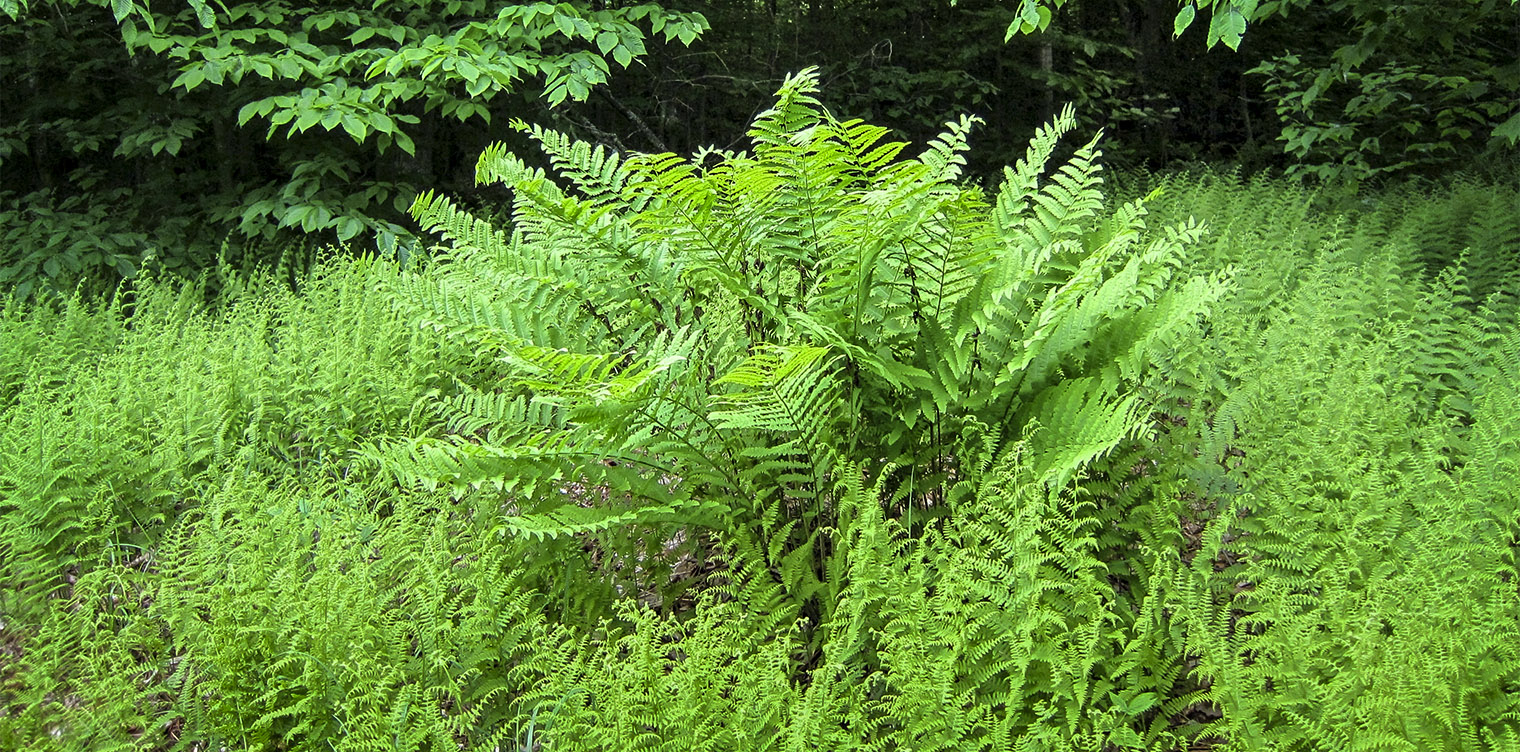
The Interrupted Fern (Osmunda claytoniana) is a large, vase-shaped fern that grows in both wetlands and non-wetlands in the Adirondack Mountains. Its fertile fronds are interrupted by spore-bearing leaflets in early summer.
The Interrupted Fern is a member of the Osmundaceae family (Royal Fern Family). This family contains two genera:
- The Interrupted Fern is part of the genus Osmunda. This genus also includes the Royal Fern – another fern which flourishes in the Adirondack Mountains, although it is usually more restricted to wetter sites than the Interrupted Fern.
- The other genus (Osmundastrum) includes the Cinnamon Fern, another fern commonly found in wetlands in the Adirondack Park.
The origin of the genus name (Osmunda) is unclear. The most popular theory is that it was originally derived from the Saxon name for the Norse god Thor, who (according to legend) hid his family from danger in a clump of these ferns.
The species name (claytoniana) is a tribute to John Clayton, an 18th century botanist and one of the earliest collectors of plant specimens in what later became the Commonwealth of Virginia. The common name (Interrupted Fern) is a reference to the fact that the blade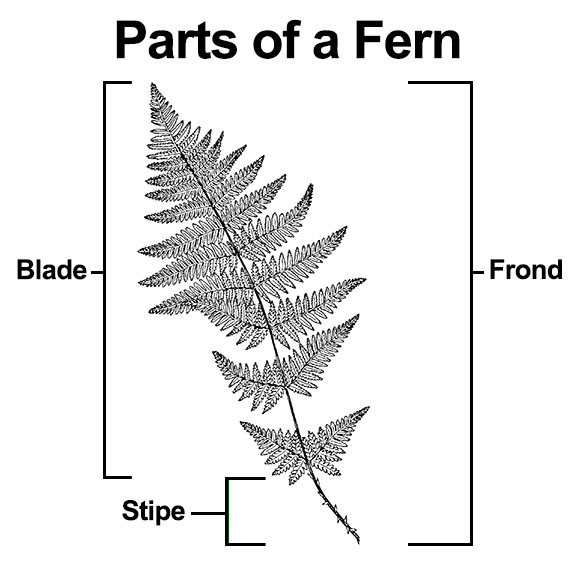 Blade: The expanded, leafy part of the frond. of fertile fronds is interrupted by several fertile leaflets in the midsection. Early sources refer to this fern as Clayton's Fern.
Blade: The expanded, leafy part of the frond. of fertile fronds is interrupted by several fertile leaflets in the midsection. Early sources refer to this fern as Clayton's Fern.
Identification of Interrupted Ferns
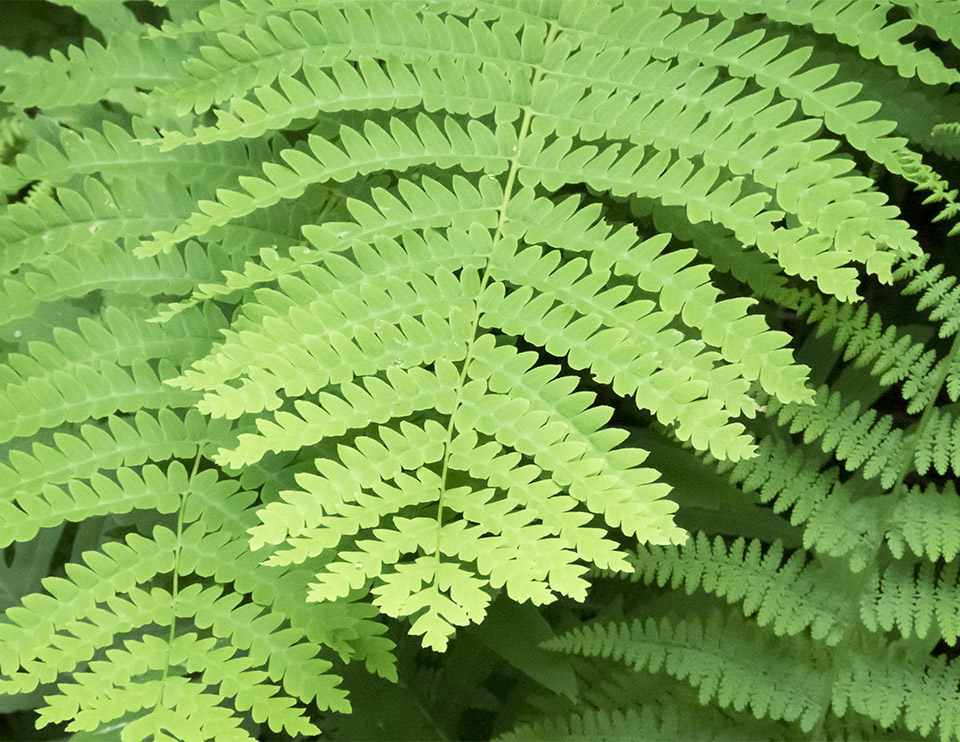
Interrupted Ferns are large, vase-shaped ferns, usually growing up to three or four feet tall. These are deciduous ferns, which turn golden yellow in the fall before dying back.
Interrupted Ferns are dimorphicFrond dimorphism: Refers to a difference in ferns between the fertile and sterile fronds., which means that the sterile fronds and fertile fronds are different in appearance. The sterile frondsSterile frond: A frond without sporangia (spore cases). grow in an arching, circular clump emanating from the rhizome Rhizome: The modified subterranean stem of a plant that sends out roots and shoots from its nodes. Rhizomes are also called creeping rootstalks and rootstocks..
Rhizome: The modified subterranean stem of a plant that sends out roots and shoots from its nodes. Rhizomes are also called creeping rootstalks and rootstocks..
- The sterile fronds are broadest in the middle area, woolly at the beginning of the season, then becoming hairless.
- Each sterile frond is cut into ten to twenty pairs of pinnae
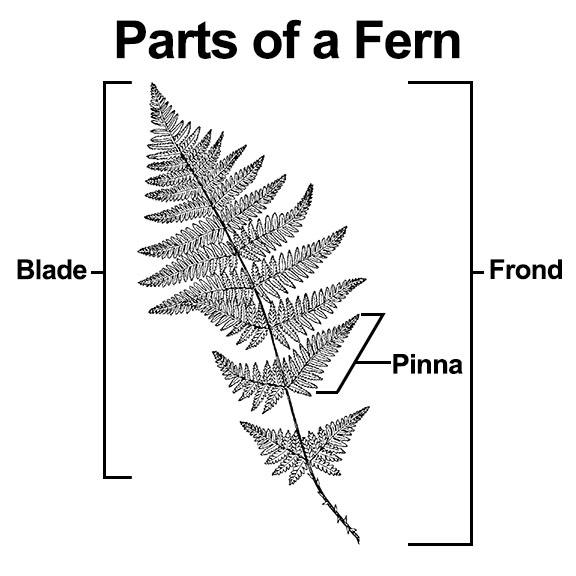 Pinna: A primary division of the blade (plural: pinnae). (leaflets). The leaflets are arranged in an opposite fashion, meaning that they emerge from the rachis
Pinna: A primary division of the blade (plural: pinnae). (leaflets). The leaflets are arranged in an opposite fashion, meaning that they emerge from the rachis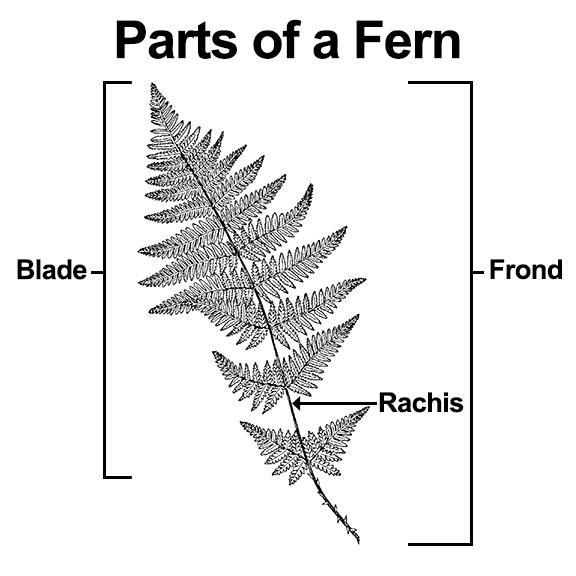 Rachis: The stalk within the blade (the expanded, leafy part of the frond). (stalk) in pairs.
Rachis: The stalk within the blade (the expanded, leafy part of the frond). (stalk) in pairs. - Sterile pinnae are narrow, blunt at the tip, and bluish green in color.
- The leaflets are smooth
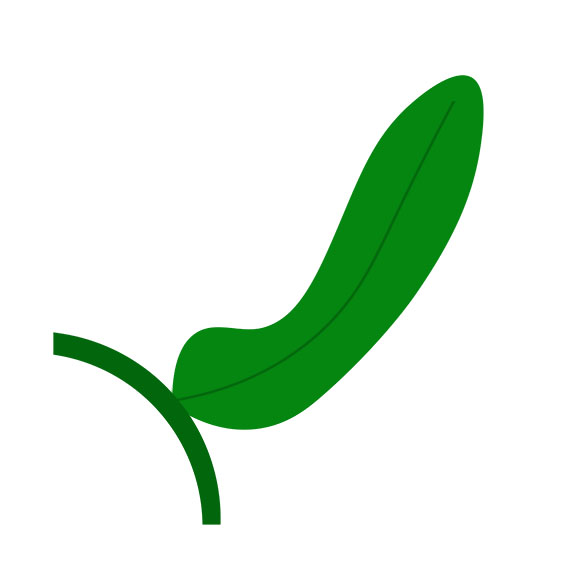 Smooth: Refers to the margin (edge) of a pinna or pinnule which is smooth, lacking teeth.. (lacking teeth), and the lobes are overlapping.
Smooth: Refers to the margin (edge) of a pinna or pinnule which is smooth, lacking teeth.. (lacking teeth), and the lobes are overlapping. - There is no tuft of reddish hairs at the base, as is the case with the Cinnamon Fern.
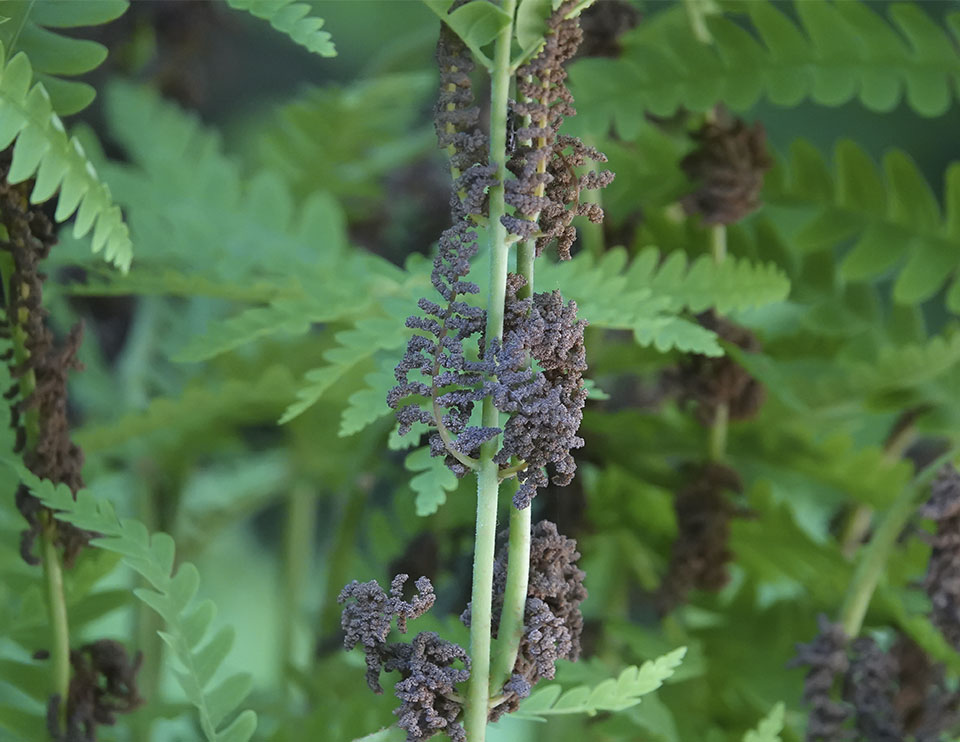
The Interrupted Fern's fertile frondsFertile frond: A frond with sporangia (spore cases). tend to be more upright than the sterile fronds. The fertile fronds usually appear in the center of the fern, surrounded by sterile fronds.
Fertile fronds have two different kinds of leaflets: sterile and fertile. The sterile green leaflets appear near the top of the blade and near the bottom. In the midsection of the fertile fronds are several pairs of fertile leaflets.
These fertile leaflets bear clusters of sporangiaSporangium: Spore cases inside which the spores develop. (plural = sporangia) (spore cases). These are a dark greenish brown at maturity, turning dark brown after they have released their spores. The sporangia then dry up and fall away from the frond, leaving an "interruption" in the middle of the fertile frond.
The main key to identifying the Interrupted Fern and differentiating it from other ferns is the structure of its fertile fronds, which differ in appearance from its sterile fronds. The Interrupted Fern shares this characteristic with Royal Ferns, Cinnamon Ferns, and Sensitive Ferns. These ferns are often found in similar habitats as the Interrupted Fern, although the Interrupted Fern is somewhat less fussy about its growing conditions.
- As with the Interrupted Fern, the fertile fronds of Cinnamon Ferns appear in the center of the sterile fronds. However, the Cinnamon Fern's fertile fronds lack the green leaflets on the top half and lower half of the fertile frond, which is characteristic of the Interrupted Fern. In addition, the sterile leaflets of Cinnamon Ferns have persistent tufts of woolly hair at the base. This feature distinguishes the Cinnamon Fern from the Interrupted Fern, which lacks these tufts.
- The Interrupted Fern can be distinguished from the Royal Fern by the placement of the fertile leaflets. The Interrupted Fern's fertile fronds are "interrupted" by two to five pairs of fertile leaflets in the midsection. By contrast, the Royal Fern's fertile leaflets are at the end of the blade
 Blade: The expanded, leafy part of the frond..
Blade: The expanded, leafy part of the frond.. - The fertile blades of Sensitive Ferns have bead-like fertile leaflets and lack the green leaflets characteristic of the Interrupted Fern.
Uses of Interrupted Ferns
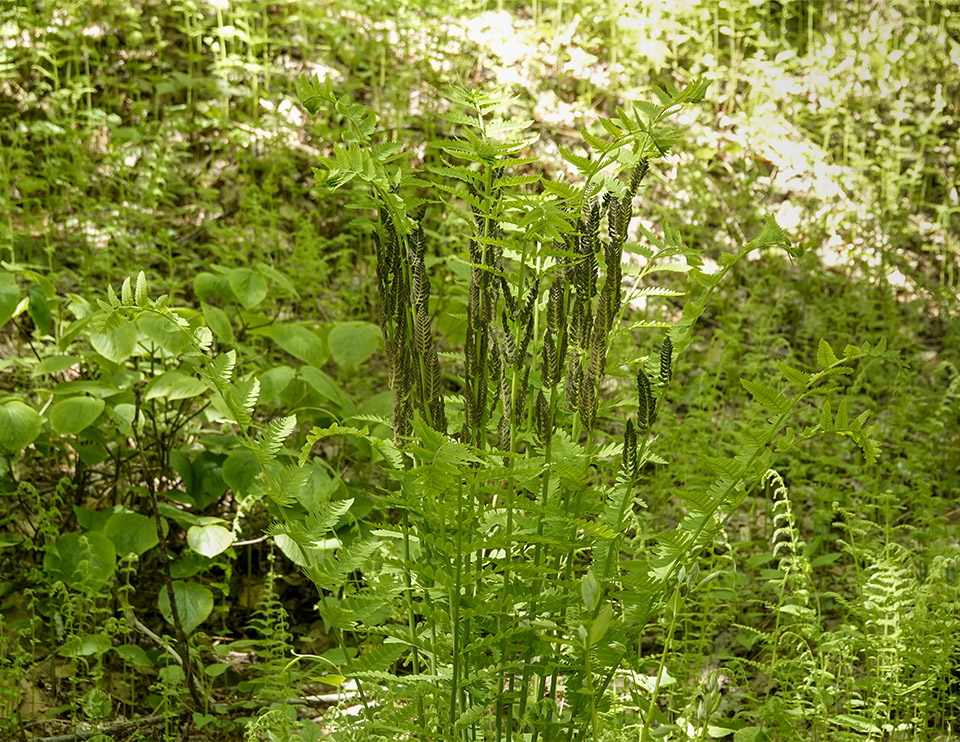
The Interrupted Fern does not appear to have been used extensively for medicinal purposes. One native American group (the Iroquois) reportedly used it as treatment for gonorrhea; another report suggests that the fern was once used as a remedy for rickets.
No edible uses of this fern were found. Several sources caution against ingestion of this and other ferns, especially in large quantities, since some ferns contain carcinogens, and many contain thiaminase, an enzyme that robs the body of its vitamin B complex.
Wildlife Value of Interrupted Ferns
Interrupted Ferns have minimal value as a food source for wildlife. The minute size of fern spores eliminates them as a significant food source. The foliage of this fern is bitter and may be toxic, so it is rarely eaten by mammals. Moreover, the Interrupted Fern is not evergreen, so its foliage does not provide an emergency winter food source. When Interrupted Ferns occur in colonies, they can provide protective cover for wildlife.
Relatively few insects feed on the Interrupted Fern. An exception is the Osmunda Borer Moth, whose caterpillars consume the fern, as do those of the Tortricid Moth and the Sharp Angle Shades moth.
Distribution of Interrupted Ferns
Interrupted Ferns are found in eastern North America, from Newfoundland to southeastern Manitoba south to Georgia, Kentucky, and Arkansas. This fern is listed as Threatened in Arkansas and Exploitably Vulnerable in New York State, where it is found in most counties (with the exception of several in western New York).
Interrupted Ferns occur in all counties within the Adirondack Park Blue Line.
Habitat of Interrupted Ferns
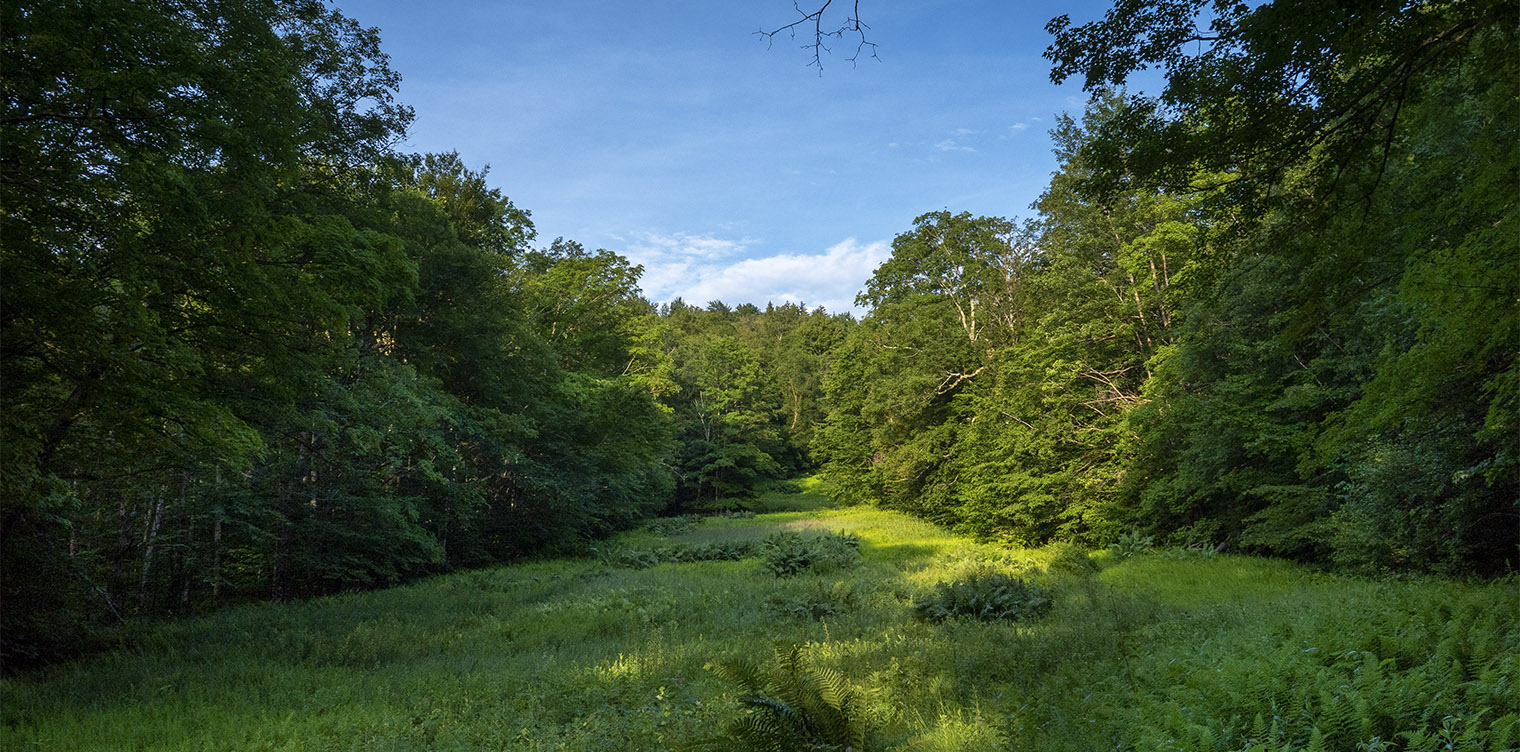
Interrupted Ferns are fairly flexible in terms of soil and sun. They apparently prefer dappled sunlight to light shade, but can also grow in shade and even in full sun. They occur on both wet and fairly well-drained sites and acid to neutral soil.
This relative flexibility means that Interrupted Ferns are found in a wide range of habitats, including northern hardwood forests, spruce-fir stands, swamps, ditches, wet roadsides, stream edges, woodland edges, and wet or dry meadows. Interrupted Ferns are found on similar sites as the Cinnamon Fern, but are somewhat more flexible in terms of site requirements than Cinnamon Ferns. In the Adirondack Mountains, Interrupted Ferns can be found in several ecological communities, including Riverside Ice Meadow, Spruce Flats, Successional Old Field, and Successional Northern Hardwoods.
Interrupted Ferns can be seen on several of the trails covered here.
- There is an Interrupted Fern identified with an interpretive sign in the Fern Garden adjacent to the Nature Museum at Heart Lake. You can also see some particularly striking specimens growing on the ski slope on the Heart Lake Trail.
- This fern can be found growing in successional forest on the Big Field Connector at Heaven Hill.
- You can also find Interrupted Ferns on the northern sections of the Logger's Loop Trail at the Paul Smith's College VIC where the trail leads through the Forest Ecosystem Research and Demonstration Area (FERDA), showcasing the impacts of different logging practices on natural communities.
List of Adirondack Ferns
References
Michael Kudish. Adirondack Upland Flora: An Ecological Perspective (The Chauncy Press, 1992), pp. 81-82.
Boughton Cobb. A Field Guide to Ferns and their Related Families. Northeastern and Central North America. Second Edition (Houghton Mifflin Company, 2005), pp. 170-171, 174-175. Retrieved 23 June 2022.
Michael Burgess. A Field Guide to the Ferns of New England and Adjacent New York, pp. 14, 27, 98-99. Undated. Retrieved 16 February 2017.
Richard Mitchell. Atlas of New York State Ferns (New York State Museum, 1984), p. 5. Retrieved 15 February 2017.
Eugene C. Ogden. Field Guide to Northeastern Ferns (New York State Museum, 1981), p. 89, Plate 41. Retrieved 15 February 2017.
William J. Cody and Donald M. Britton. Ferns and Fern Allies of Canada (Research Branch. Agriculture Canada, 1989), pp. 124, 126-127, 345. Retrieved 23 June 2022.
William J. Cody. Ferns of the Ottawa District (Research Branch. Agriculture Canada, 1978), pp. 28-29. Retrieved 23 June 2022
David B. Lellinger. A Field Manual of the Ferns & Fern Allies of the United States and Canada (Smithsonian Institution Press, 1985), pp. 120-122, Plate 125.
Anne C. Hallowell and Barbara G. Hallowell. Fern Finder. Second Edition (Nature Study Guild Publishers, 2001), p. 41.
George Henry Tilton, "Interrupted Fern. Clayton's Fern," The Fern Lover's Companion. A Guide for the Northeastern States and Canada (Little, Brown, 1923. Retrieved 10 January 2018.
R.C. Benedict, "An Adirondack Fern List," American Fern Journal, Volume 6, Number 3, July-September 1916, pp. 81-85. Retrieved 10 January 2018.
New York Flora Association. New York Flora Atlas. Interrupted Fern. Osmunda claytoniana L. Retrieved 23 June 2022.
Integrated Taxonomic Information System. Osmunda claytoniana L. Retrieved 24 January 2018.
United States Department of Agriculture. The Plants Database. Interrupted Fern. Osmunda claytoniana L. Retrieved 24 January 2018.
Flora of North America. Interrupted Fern. Osmunda claytoniana Linnaeus, Retrieved 23 January 2018.
NatureServe Explorer. Online Encyclopedia of Life. Interrupted Fern. Osmunda claytoniana - L. Retrieved 23 January 2018.
Native Plant Trust. Go Botany. Interrupted Fern. Osmunda claytoniana L. Retrieved 19 December 2019.
New York State. Department of Environmental Conservation. New York Natural Heritage Program. Ecological Communities of New York State. Second Edition (March 2014), pp. 87, 122. Retrieved 23 June 2022.
New York Natural Heritage Program. 2022. Online Conservation Guide for Riverside Ice Meadow. Retrieved 23 June 2022.
New York Natural Heritage Program. 2022. Online Conservation Guide for Spruce Flats. Retrieved 23 June 2022.
New York State. Adirondack Park Agency. Preliminary List of Species Native Within the Adirondack Park Listed Alphabetically by Scientific Name and Sorted by Habit. Volume 1. Updated 10.23.2006, p. 59. Retrieved 26 January 2017.
iNaturalist. Adirondack Park Observations. Interrupted Fern. Osmunda claytoniana. Retrieved 23 June 2022.
Connecticut Botanical Society. Interrupted Fern. Osmunda claytoniana L. Retrieved 23 June 2022.
University of Wisconsin. Flora of Wisconsin. Interrupted Fern, Osmunda claytoniana L. Retrieved 23 January 2018.
Minnesota Wildflowers. A Field Guide to the Flora of Minnesota. Osmunda claytoniana. Interrupted Fern. Retrieved 23 June 2022.
Illinois Wildflowers. Grasses, Sedges, & Non-Flowering Plants. Interrupted Fern. Osmunda claytoniana. Retrieved 23 January 2018.
Eloise Butler Wildflower Garden. The Friends of the Wild Flower Garden. Interrupted Fern. Osmunda claytoniana L. Retrieved 23 January 2018.
Lady Bird Johnson Wildflower Center. Interrupted Fern. Osmunda claytoniana. Retrieved 23 January 2018.
Meiyin Wu & Dennis Kalma. Wetland Plants of the Adirondacks: Ferns, Woody Plants, and Graminoids (Trafford Publishing, 2011), p. 20.
Gary Wade et al. Vascular Plant Species of the Forest Ecology Research and Demonstration Area, Paul Smiths, New York. USDA Forest Service. Research Note NE-380, p. 4. Retrieved 22 January 2017.
Mark J. Twery, et al. Changes in Abundance of Vascular Plants under Varying Silvicultural Systems at the Forest Ecosystem Research and Demonstration Area, Paul Smiths, New York. USDA Forest Service. Research Note NRS-169, p. 9. Retrieved 22 January 2017.
Alexander C. Martin, Herbert S. Zim, and Arnold L. Nelson. American Wildlife & Plants. A Guide to Wildlife Food Habits (Dover Publications, 1951), p. 369. Retrieved 23 June 2022.
Plants for a Future. Osmunda claytoniana - L. Retrieved 23 January 2018.
University of Michigan. Native American Ethnobotany. A Database of Foods, Drugs, Dyes and Fibers of Native American Peoples, Derived from Plants. Interrupted Fern. Osmunda claytoniana L. Retrieved 24 January 2018.
Iowa State University. BugGuide. Conservula anodonta. Retrieved 24 January 2018.
Allen J. Coombes. Dictionary of Plant Names (Timber Press, 1993), p. 132. Retrieved 23 June 2022.
Charles H. Peck. Plants of North Elba. (Bulletin of the New York State Museum, Volume 6, Number 28, June 1899), p. 156. Retrieved 22 February 2017.
"John Clayton (1695-1773)," Encyclopedia Virginia. Retrieved 24 January 2018.
